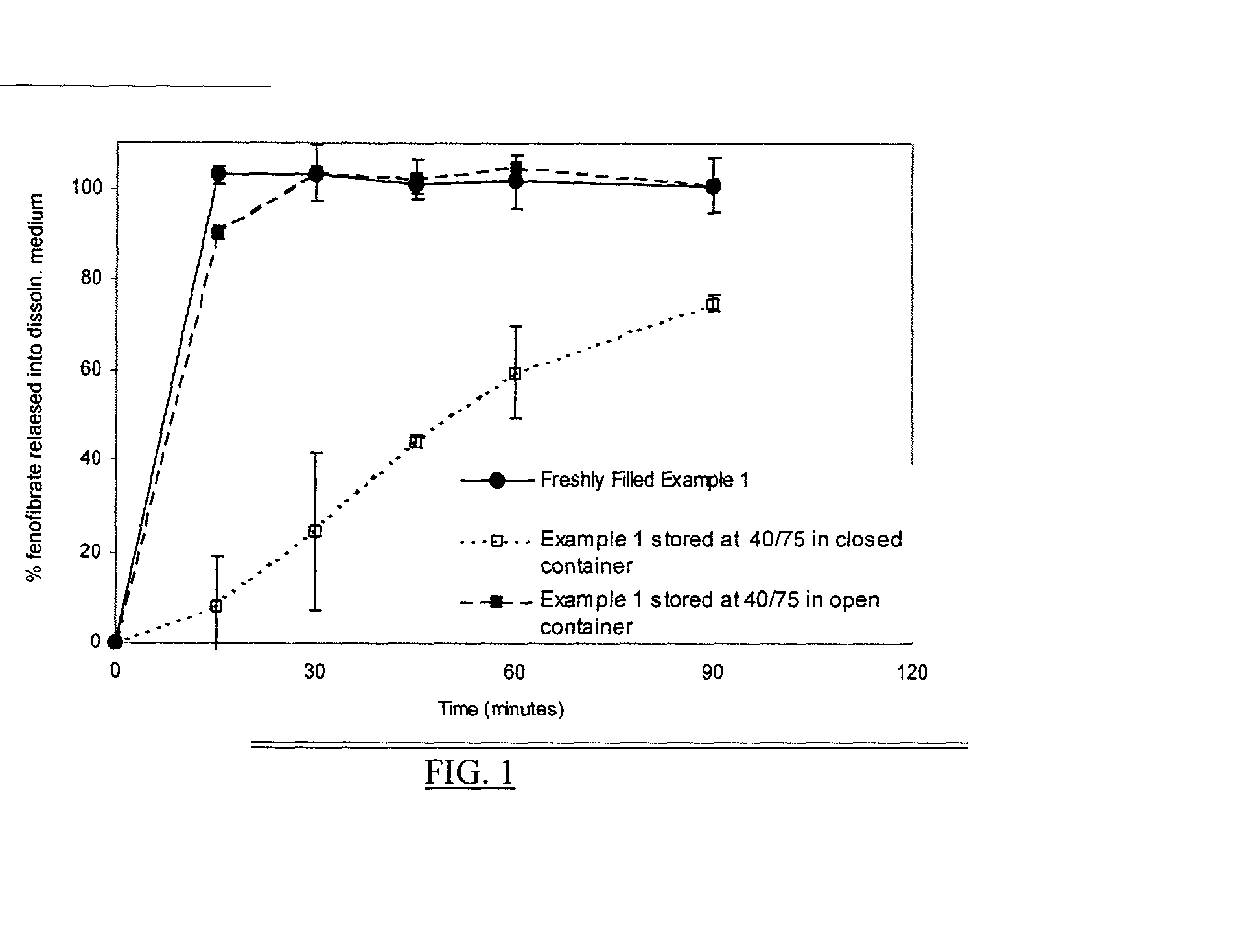Pharmaceutical dosage forms for highly hydrophilic materials
a technology of hydrophilic materials and pharmaceuticals, applied in the direction of pharmaceutical delivery mechanism, organic active ingredients, capsule delivery, etc., can solve the problems of capsule brittleness upon storage, inconsistent performance of these dosage forms, poor absorption of active ingredients,
- Summary
- Abstract
- Description
- Claims
- Application Information
AI Technical Summary
Problems solved by technology
Method used
Image
Examples
example 1
[0224]
20 a) Fill composition (% by weight) Fenofibrate 8 Cremphor EL 35 Labrasol 22 Labrafil M2125CS 35
[0225] The traditional airfills encapsulating the above-recited fill composition were stored at 40.degree. C. / 75% RH in closed and an open containers for 4 weeks. These capsules along with freshly filled capsules were subject to dissolution testing (USP type I) in 1 L of SGF with 25 mM sodium lauryl sulfate at 37.degree. C. The release profiles of fenofibrate from the capsules under different storage conditions are demonstrated in FIG. 1
[0226] As can be seen, the capsules stored at 40.degree. C. / 75% RH in a closed container produced a slower and incomplete release of fenofibrate. It also should be noted that there were ghost capsules or the pellicle formation observed from the capsules. These observations highlight the incompatibility between the highly hydrophilic fill material containing more than 40% by weight of hydrophilic surfactants in the carrier and the traditional gelatin...
example 2
[0229]
21 a) Fill composition (% by weight) Fenofibrate 8 Cremphor EL 42 Labrasol 20 Labrafil M2125CS 30 b) Shell (dry) composition (% by weight) Gelatin 54 Glycerin 18 Sorbitol / Sorbitan(s) mixture 22 Water 6 The dry gelatin shell (capsule) is produced from a fluid gelatin composition using the following constituents: c) Shell (fluid formation) (% by weight) Gelatin 42 Glycerol 10 Sorbitol / Sorbitan(s) mixture 12 (R 2*) Water 36
example 3
[0230]
22 a) Fill composition (% by weight) Fenofibrate 12 (4 parts suspended) Cremphor EL 40 Labrasol 26 Labrafil M2125CS 22 Lutrol F68 2 b) Shell (dry) composition (% by weight) Gelatin 47 Glycerin 28 Sorbitol / Sorbitan(s) mixture 15 (R 1*) Water 10 The sorbitol / sorbitan(s) mixtures usually contain sorbitol and at least one sorbitan in a ratio (R)* of sorbitol to sorbitan(s) ranging from about 0.2 to 5, preferably from about 0.5 to 2.5 by weight. Sorbitol / sorbitan(s) mix-tures are commercially available under various trade names. Due to their particular processes, these mixtures of sorbitol and sorbitan(s) may further include other polyhydric alcohol(s) such as mannitol, isosorbide or other polyols. In these cases, the total amount of sorbitol and sorbitan(s) in the whole sorbitol / sorbitan(s) / polyhydric alcohol(s) mixtures ranges from 40-80% by weight, preferably from 50-70% by weight. One suitable commercially available mixture of sorbitol / sorbitans / polyhydric alcohols is under the...
PUM
| Property | Measurement | Unit |
|---|---|---|
| Fraction | aaaaa | aaaaa |
| Fraction | aaaaa | aaaaa |
| Fraction | aaaaa | aaaaa |
Abstract
Description
Claims
Application Information
 Login to View More
Login to View More - R&D
- Intellectual Property
- Life Sciences
- Materials
- Tech Scout
- Unparalleled Data Quality
- Higher Quality Content
- 60% Fewer Hallucinations
Browse by: Latest US Patents, China's latest patents, Technical Efficacy Thesaurus, Application Domain, Technology Topic, Popular Technical Reports.
© 2025 PatSnap. All rights reserved.Legal|Privacy policy|Modern Slavery Act Transparency Statement|Sitemap|About US| Contact US: help@patsnap.com

